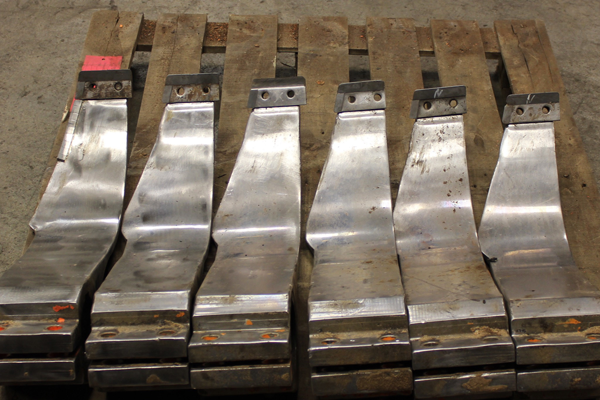The Difference a Carbide Lead Edge Can Make
When it comes to debarker arm maintenance, you’ll hear us talking about the carbide lead edge. A lot. The reason is that this application can make an incredible difference in extending the life of a debarker arm, reducing excessive wear and damage to the debarker tip, improving chip and lumber quality and increasing overall recovery. To begin with, we’ll explain a bit more about what the carbide lead edge is all about.
The Carbide Lead Edge
There are three different styles of debarker arm lead edges that can be found on the market — regular high alloy steel typically used in original designs, hard surface treatment and carbide. Regular high alloy steel will likely wear down the fastest, then hard surface and then carbide. In a carbide lead edge application, pieces of carbide are brazed into the lead edge, acting as armour for the lead edge. Carbide itself, is an incredibly tough material that has been found to last 10 times longer than regular tool steel when used on cutting tools. In this case, not only does the carbide protect the arm but it also maintains the lead edge sharpness, allowing the debarker arms to open easier as the log passes through.
Why the lead edge matters
The lead edge of the debarker arm is the first line of defense when the log is passing through the debarker, so when it wears down, a whole host of issues will start to occur. With a worn down lead edge, the log will start hitting the tip first rather than the lead edge or even hook the corner of the tip that is now exposed. This can cause excessive damage to the tip and the bolt can break, causing the tip to fall right off. With the loss of the debarker tip, the arm is now exposed to further damage coming into direct contact with the log and the log itself will be left with strips of bark which can lead to bark contamination.
Carbide Lead Edge vs. Regular High Alloy Steel
Below is a shipment of six arms that we received for repair. All of these arms were in use for the same amount of time but five of the six arms that were original design made with regular high alloy steel have significant wear on the lead edge and require a lot of welding and buildup which is a costly repair. The arm on the left that was one that had received our carbide lead edge application actually could have stayed in service and will only need minimal buildup on the back side of the arm.
The carbide lead edge can be applied to nearly any debarker arm. At Webco we can repair worn arms by building up the lead edge and then installing the carbide lead edge with special brazing techniques to make sure it won’t be knocked loose in harsh environments. We also manufacture new carbide lead edge arms for all styles and sizes of machines. If you’re interested in how using a carbide lead edge debarker arm could work in your sawmill, feel free to contact us.




